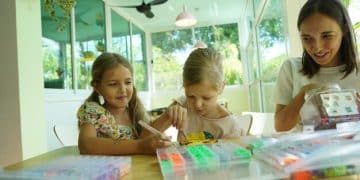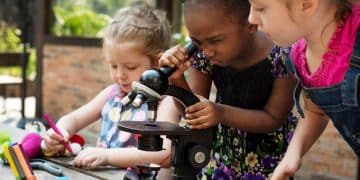The Importance of Play: Unstructured Activities for Child Development

The importance of play in child development is paramount, fostering creativity, problem-solving skills, and social-emotional intelligence through unstructured activities.
Unlocking a child’s full potential often begins with something as simple as play. The importance of play: how unstructured activities boost child development is profound, shaping their cognitive, emotional, and social skills in ways that structured learning simply cannot replicate.
Understanding the Essence of Unstructured Play
Unstructured play, at its core, is child-led and imaginative. It allows children to explore their interests, make their own rules, and learn at their own pace, all while having fun.
Unlike organized sports or academic tutoring, unstructured play doesn’t have a specific learning objective. It’s about the process of discovery, the joy of creation, and the freedom to explore without the pressure of performance.
Defining Unstructured Play
Unstructured play encompasses various activities, from building forts in the living room to playing pretend in the backyard. It’s about letting children use their imaginations without adult intervention.
Benefits of Unstructured Play
The benefits of unstructured play are numerous, impacting a child’s cognitive, emotional, and social development. It allows them to explore their creativity, problem-solving skills, and social interaction abilities.
- Enhances creativity and imagination.
- Develops problem-solving skills.
- Improves social-emotional intelligence.
- Promotes physical health and coordination.
In summary, unstructured play is critical for holistic child development, nurturing skills and traits that structured activities often miss.

Cognitive Development Through Play
Cognitive development is significantly enhanced through unstructured play. These activities provide children with opportunities to make choices, solve problems, and think critically. This form of learning is organic and deeply engaging.
When children are free to explore without the constraints of predetermined rules, they are more likely to develop innovative and adaptable thinking patterns.
How Play Enhances Cognitive Skills
Every playtime scenario offers a chance for cognitive growth. From planning a tea party to constructing a spaceship from cardboard boxes, each activity requires thought, strategy, and creativity.
Real-life Cognitive Examples from Play
Let’s consider a few examples. Children playing “house” might negotiate roles, plan activities, and even resolve conflicts, all of which sharpen their cognitive abilities.
- Boosts problem-solving skills through hands-on challenges.
- Enhances critical thinking by encouraging self-directed learning.
- Supports creativity and innovation through imaginative scenarios.
- Improves decision-making by allowing children to make choices in play.
In conclusion, unstructured play serves as a fertile ground for nurturing cognitive skills that are essential for a child’s future.
Emotional Development and Expression
Emotional development is another cornerstone of child’s growth nurtured by unstructured play. This environment fosters emotional expression, empathy, and self-regulation. Activities promoting these skills are invaluable for a child’s emotional well-being.
Allowing children to engage in play without strict rules or expectations provides a safe space to explore and express their feelings authentically.
The Role of Play in Emotional Growth
Through play, children learn to recognize and manage their emotions. They experience joy, frustration, excitement, and disappointment in a safe environment.
Practical Examples of Emotional Learning During Play
Playing pretend allows children to step into different roles and experience various emotions. They learn to empathize with others and understand different perspectives, fostering emotional intelligence.
- Facilitates emotional expression in a safe, controlled environment.
- Encourages empathy and understanding of others’ feelings.
- Teaches self-regulation as children manage conflicts and frustrations.
- Promotes resilience by dealing with challenges during play.
Finalizando, unstructured play helps children develop a strong emotional foundation. This foundation is essential for navigating life’s challenges and building healthy relationships.
Social Skills Flourish Through Play
Social skills are significantly honed through unstructured play. As children play together, they learn to cooperate, compromise, and communicate effectively. Every interaction becomes a lesson in social dynamics.
Unstructured play creates opportunities for children to interact with their peers, fostering the development of essential social skills. These skills are critical for navigating social situations throughout life.
Playtime Dynamics and Social Learning
Whether they’re building a fort, playing tag, or creating an imaginary world, children constantly negotiate roles, rules, and expectations. These interactions enhance their social intelligence and cooperation skills.
Scenario-based Social Skill Development
Consider the scenario where children disagree on the rules of a game. They must communicate their perspectives, listen to each other, and find a compromise. This teaches them conflict resolution and negotiation skills.
- Encourages cooperation and teamwork in group activities.
- Develops communication skills as children negotiate and express ideas.
- Teaches conflict resolution and compromise when disagreements arise.
- Fosters empathy as children consider others’ perspectives.
In essence, unstructured play provides a dynamic platform for children to refine their social skills. These skills are invaluable for building positive relationships and succeeding in various social settings.

Physical Health and Motor Skills
Physical health and the development of motor skills are integral components of overall child wellness. Unstructured play is vital in supporting these areas. It encourages active movement, enhancing both gross and fine motor skills.
Unstructured play involves a wide range of physical activities. These activities help strengthen muscles, improve coordination, and promote a healthy lifestyle from an early age.
The Physical Benefits of Play
Running, jumping, climbing, and building all contribute to the development of gross motor skills. Activities like drawing, crafting, and playing with small toys enhance fine motor skills.
Activities for Physical Growth
Organizing a backyard obstacle course, playing hopscotch, or building a LEGO masterpiece are excellent ways to promote physical activity and skill development.
- Improves gross motor skills through running, jumping, and climbing.
- Enhances fine motor skills via drawing, building, and crafting.
- Promotes cardiovascular health by encouraging physical activity.
- Supports muscle development and coordination through various play activities.
Ultimately, unstructured play is a fun and effective way to promote physical health and motor skills development in children. By staying active and engaged, children build a foundation for lifelong health and well-being.
Balancing Play with Structured Activities
Finding the right balance between unstructured play and structured activities is key to maximizing a child’s development. While structured activities provide targeted learning and skill-building, unstructured play is essential for creativity, exploration, and emotional growth.
Both types of activities have unique benefits. Integrating them thoughtfully into a child’s routine ensures comprehensive development.
Advantages of Both Play Types
Structured activities provide children with specific knowledge and skills, such as music lessons or sports training. Unstructured play nurtures creativity, problem-solving, and emotional intelligence.
Creating a Balanced Schedule
Aim to incorporate both into the daily or weekly routine. For instance, a child might attend a soccer practice (structured) and then spend the afternoon building a fort in the backyard (unstructured).
- Integrate structured activities for skill-building and targeted learning.
- Incorporate unstructured play for creativity, exploration, and emotional growth.
- Create a daily or weekly balance to ensure comprehensive development.
- Consider the child’s interests and preferences when planning activities.
To summarize, balancing structured and unstructured activities creates a well-rounded development experience for children, nurturing both their skills and creative potential.
Creating a Play-Conducive Environment
Creating an environment conducive to unstructured play involves providing children with the space, time, and resources they need to explore their interests and imaginations freely. This encourages them to engage in creative activities and develop their unique skills.
A play-conducive environment is safe, stimulating, and allows children to express themselves without fear of judgment or restriction.
Elements of a Play-Friendly Space
This might include a backyard with natural elements like trees and sand, a playroom filled with art supplies and toys, or even a quiet corner in the living room designated for play.
Resources That Encourage Play
Providing a variety of materials such as blocks, dress-up clothes, art supplies, and natural items like sticks and stones can inspire creativity and imagination.
- Offer a safe and stimulating space for children to explore.
- Provide diverse materials and resources to inspire creativity.
- Allow children the freedom to make choices and direct their play.
- Minimize interruptions and create dedicated playtime.
In essence, creating a play-conducive environment requires a thoughtful approach to space and resources. By providing children with the freedom and materials they need, you can foster their creativity, problem-solving skills, and emotional well-being.
| Key Point | Brief Description |
|---|---|
| 🧠 Cognitive Development | Enhances problem-solving and critical thinking skills. |
| 💖 Emotional Development | Fosters emotional expression and empathy. |
| 🤝 Social Skills | Improves cooperation and communication abilities. |
| 💪 Physical Health | Supports motor skill development and physical activity. |
FAQ
▼
Unstructured play is important as it allows children to develop creativity, problem-solving skills, and social-emotional intelligence by freely exploring their interests.
▼
It enhances cognitive development by offering opportunities for decision-making, critical thinking, and creativity without the constraints of structured rules.
▼
Building forts, playing pretend, creating art projects, and exploring outdoors are excellent examples of unstructured play activities that foster creativity.
▼
Parents can encourage it by providing time, space, and resources for their children to play freely while minimizing interruptions and allowing them to make their own choices.
▼
The ideal balance involves incorporating both types of activities into the daily routine. Structured activities build specific skills, while unstructured play fosters creativity.
Conclusion
In conclusion, the importance of unstructured play in child development cannot be overstated. By embracing and encouraging these activities, parents and educators can foster well-rounded individuals. These individuals will enhance abilities from cognitive to social, and emotional intelligence.





